BY ADAM PATTERSON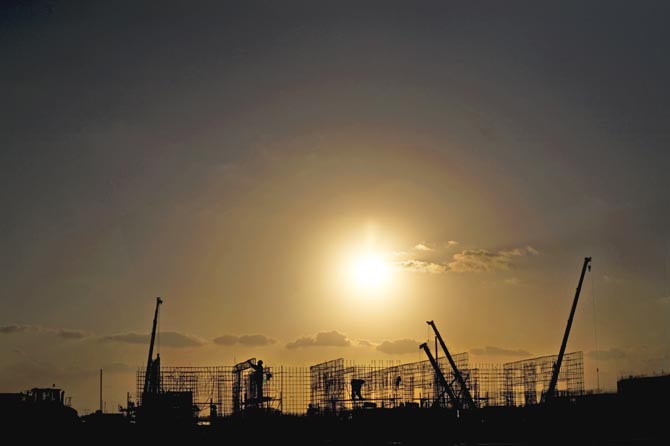
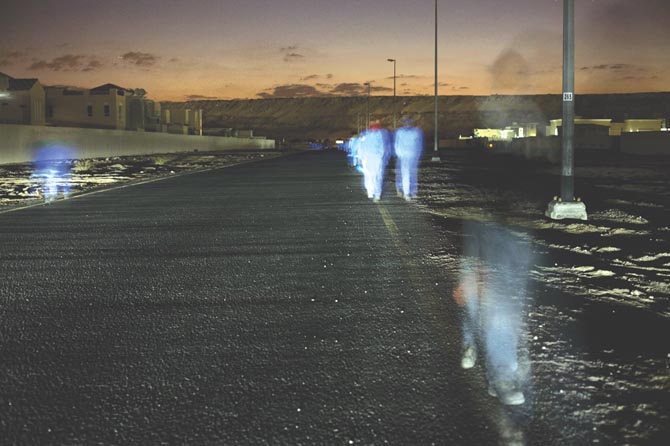 Dubai is a city where oil-rich Emiratis are willing to pay $14 million just to drive around with a license plate bearing the number “1.” (Yes, that really happened.) It’s a place filled with vast, multibillion-dollar palaces of unholy decadence, a kingdom of greed and consumption where hotels provide Westerners with 24-carat-gold facials and food prepared by Prince Charles’s ex–personal chef is served in garish dining rooms 70 feet below sea level. Even the thousands of tropical fish on display eat better than you do, feasting on nearly 500 pounds of restaurant-quality seafood buddies each day.
The contrast between the lifestyles of the tourists and those who build Dubai—the construction workers, not the faceless financiers—could not be more stark. Often they are paid $100 a month for working sweatshop hours in 120-degree heat. Employers usually confiscate their passports in exchange for jobs, as if a license to travel does a destitute worker much good. Unofficial figures say that around 1,000 of these illegally imported slaves from India and Pakistan suffered labor-related deaths last year.
As the global economy limps toward bankruptcy and the tourist trade that the city relies on dwindles, the dollars that once poured in are drying up, and layoffs have begun.
While $692 billion in building projects move ahead as planned, another $582 billion worth have been put on hold due to the economic slowdown. What will happen to Dubai’s huge monoliths of futurist architecture gone wild when there is no one to stay in them? Will they stand there and rust until they crumble? In 2008, the Wall Street Journal placed Dubai’s debt relative to gross domestic product at 42 percent. Neighboring Abu Dhabi’s debt relative to GDP is just 2.9 percent. For those who are not mathematically inclined, let’s put it this way: Insane greed plus total lack of foresight equals totally fucked.This was taken at around 4:30 AM. Workers walk to the sites from labor camps, which are often miles away. Others are shuttled on prison-style buses complete with barred windows. They are part of an approximately ten-million-strong migrant labor force.
Dubai is a city where oil-rich Emiratis are willing to pay $14 million just to drive around with a license plate bearing the number “1.” (Yes, that really happened.) It’s a place filled with vast, multibillion-dollar palaces of unholy decadence, a kingdom of greed and consumption where hotels provide Westerners with 24-carat-gold facials and food prepared by Prince Charles’s ex–personal chef is served in garish dining rooms 70 feet below sea level. Even the thousands of tropical fish on display eat better than you do, feasting on nearly 500 pounds of restaurant-quality seafood buddies each day.
The contrast between the lifestyles of the tourists and those who build Dubai—the construction workers, not the faceless financiers—could not be more stark. Often they are paid $100 a month for working sweatshop hours in 120-degree heat. Employers usually confiscate their passports in exchange for jobs, as if a license to travel does a destitute worker much good. Unofficial figures say that around 1,000 of these illegally imported slaves from India and Pakistan suffered labor-related deaths last year.
As the global economy limps toward bankruptcy and the tourist trade that the city relies on dwindles, the dollars that once poured in are drying up, and layoffs have begun.
While $692 billion in building projects move ahead as planned, another $582 billion worth have been put on hold due to the economic slowdown. What will happen to Dubai’s huge monoliths of futurist architecture gone wild when there is no one to stay in them? Will they stand there and rust until they crumble? In 2008, the Wall Street Journal placed Dubai’s debt relative to gross domestic product at 42 percent. Neighboring Abu Dhabi’s debt relative to GDP is just 2.9 percent. For those who are not mathematically inclined, let’s put it this way: Insane greed plus total lack of foresight equals totally fucked.This was taken at around 4:30 AM. Workers walk to the sites from labor camps, which are often miles away. Others are shuttled on prison-style buses complete with barred windows. They are part of an approximately ten-million-strong migrant labor force.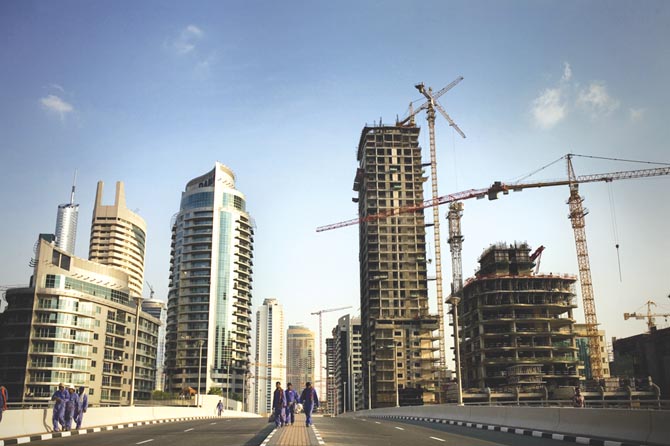 In the rush to modernize, the Emirate of Dubai has plowed any evidence of its past into the sand. There is no traditional culture here. Tourists are herded through the predictable turns like the gold souk, a fabrication catering to the Western craving for how things might have once been.
In the rush to modernize, the Emirate of Dubai has plowed any evidence of its past into the sand. There is no traditional culture here. Tourists are herded through the predictable turns like the gold souk, a fabrication catering to the Western craving for how things might have once been.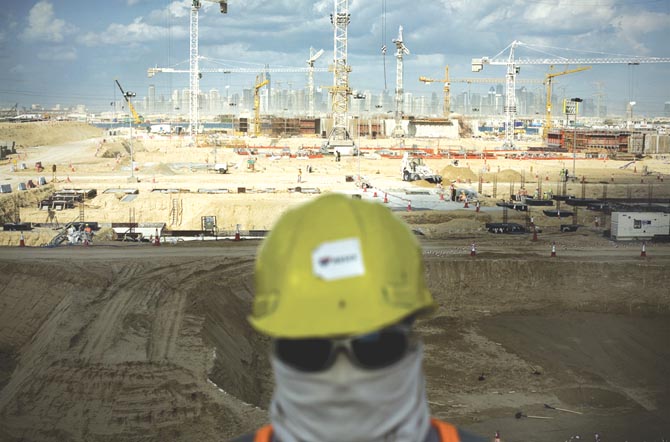 Reports in 2007 claimed that Dubai retail and commercial space covered 200 square miles, a figure projected to double this year. Fun fact: Dubai has 15 to 25 percent of the world’s cranes!
Reports in 2007 claimed that Dubai retail and commercial space covered 200 square miles, a figure projected to double this year. Fun fact: Dubai has 15 to 25 percent of the world’s cranes!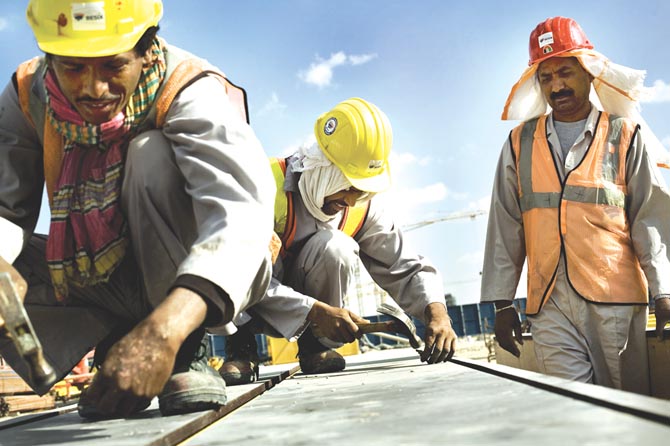 The push for Western construction butts up against the pitfalls of religious tradition. Often, workers, while observing Ramadan, collapse from dehydration and fall to their deaths.
The push for Western construction butts up against the pitfalls of religious tradition. Often, workers, while observing Ramadan, collapse from dehydration and fall to their deaths.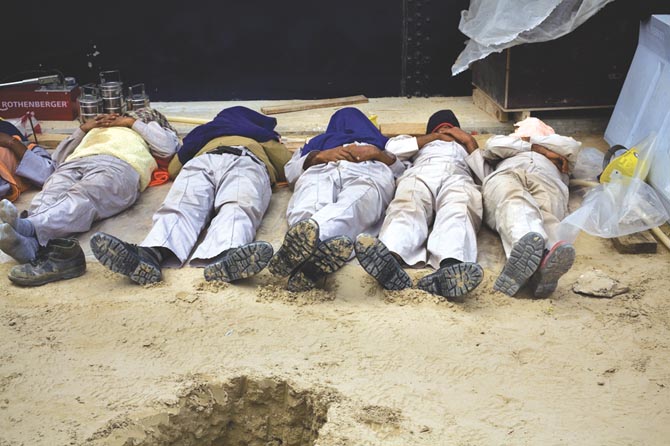 Rest during a lunch break. In summer, the midday sun can have sweat blinding your eyes within minutes.
Rest during a lunch break. In summer, the midday sun can have sweat blinding your eyes within minutes.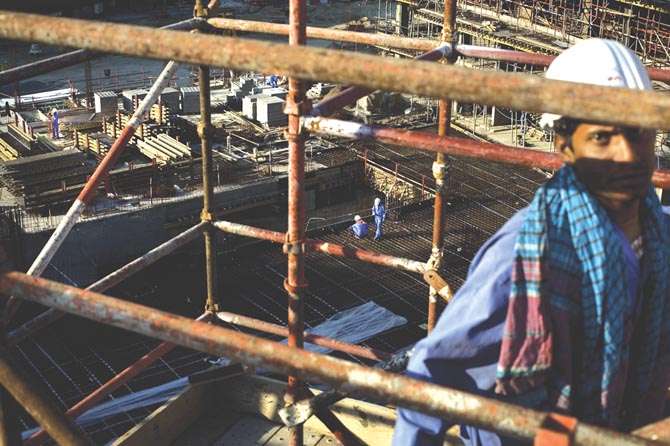 Many of the workers aspire to be taxi drivers and spend years working their way up—getting permits and passing tests. As a driver, you earn as little as a construction worker—about 500 dirhams a month ($130)—and work a 13-hour shift, with only one holiday every two years.
Many of the workers aspire to be taxi drivers and spend years working their way up—getting permits and passing tests. As a driver, you earn as little as a construction worker—about 500 dirhams a month ($130)—and work a 13-hour shift, with only one holiday every two years.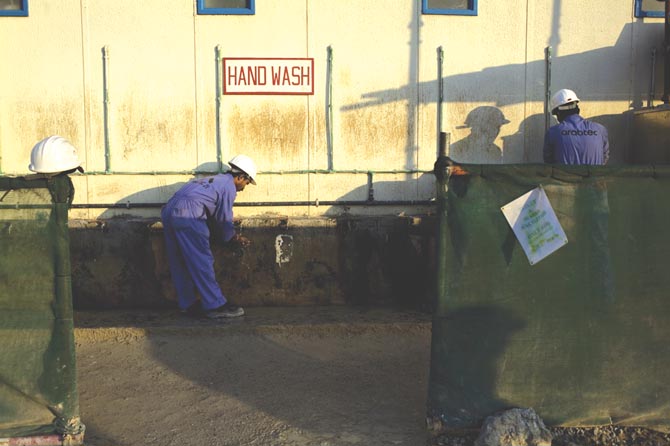 Hygiene is minimal, but the hand wash offers a nice little break. Many workers chat about their homes and families. No matter the conditions, those with a job are still earning ten times what they might at home in Pakistan, India, or Bangladesh.
Hygiene is minimal, but the hand wash offers a nice little break. Many workers chat about their homes and families. No matter the conditions, those with a job are still earning ten times what they might at home in Pakistan, India, or Bangladesh.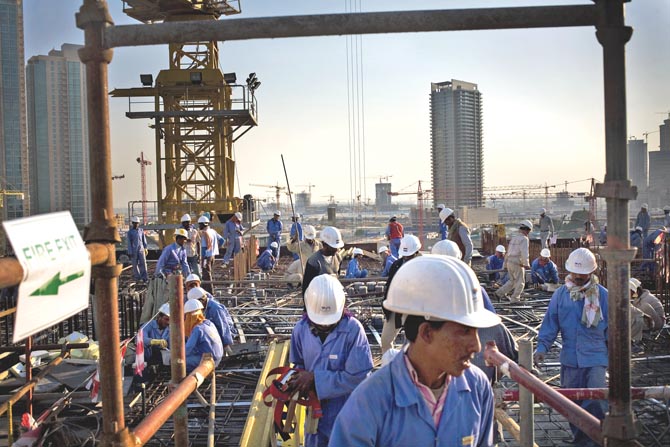 The oldest tower hails from the 70s, and its original facade was completely different from the one we see today. It was English financiers who saw potential in the tax-free zone and, with Arabic backing, exploited it. It’s Dubai law that companies have to be headed by at least one Dubai national. There also has to be a 10 percent staff of nationals at all times. If a national is fired, the company is fined by the government.
The oldest tower hails from the 70s, and its original facade was completely different from the one we see today. It was English financiers who saw potential in the tax-free zone and, with Arabic backing, exploited it. It’s Dubai law that companies have to be headed by at least one Dubai national. There also has to be a 10 percent staff of nationals at all times. If a national is fired, the company is fined by the government.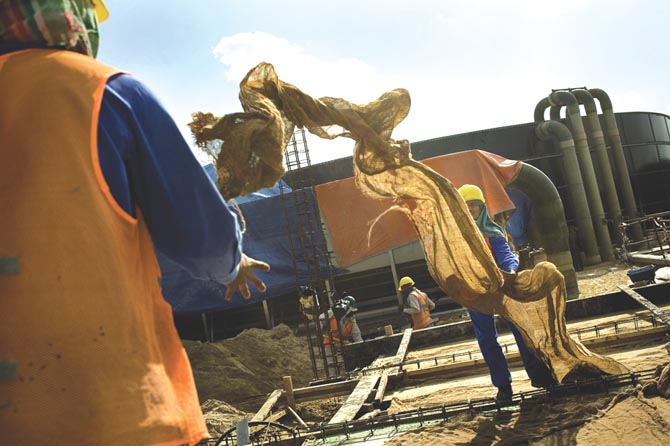 Dubai is regularly battered by shamals (windstorms) which can move at up to 50 mph and whip sand into blinding tornadoes. All of which is a lot scarier if you are working 100 feet up in the air without a harness.
Dubai is regularly battered by shamals (windstorms) which can move at up to 50 mph and whip sand into blinding tornadoes. All of which is a lot scarier if you are working 100 feet up in the air without a harness.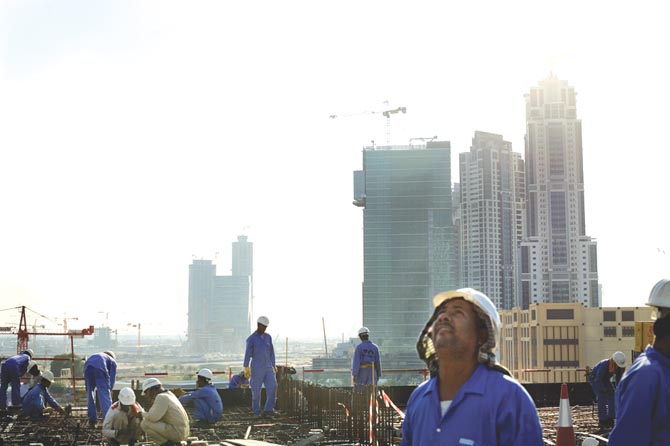 In March 2006, workers rioted on the site of the Burj Dubai, causing around $1 million in damage. Their protests led to a 20 percent increase in salary to match inflation, but failure to deliver on that promise led to further riots in October 2007, with 4,000 workers being imprisoned and later fired without pay.
In March 2006, workers rioted on the site of the Burj Dubai, causing around $1 million in damage. Their protests led to a 20 percent increase in salary to match inflation, but failure to deliver on that promise led to further riots in October 2007, with 4,000 workers being imprisoned and later fired without pay.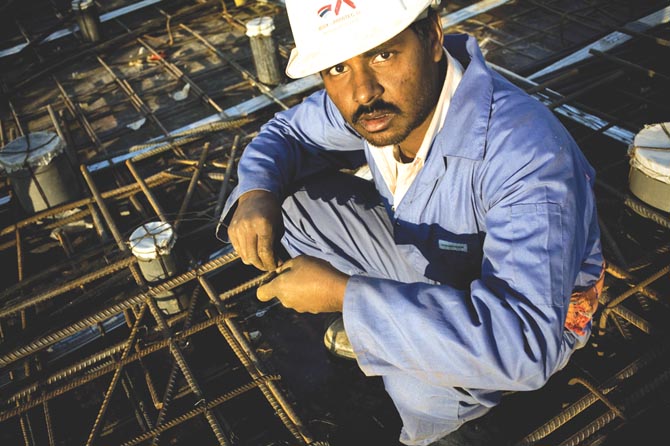 UAE labor laws, particularly in the “free zones,” are constructed to benefit the employer and undermine any rights the workers have. Migrant exploitation is almost literally government sanctioned.
UAE labor laws, particularly in the “free zones,” are constructed to benefit the employer and undermine any rights the workers have. Migrant exploitation is almost literally government sanctioned.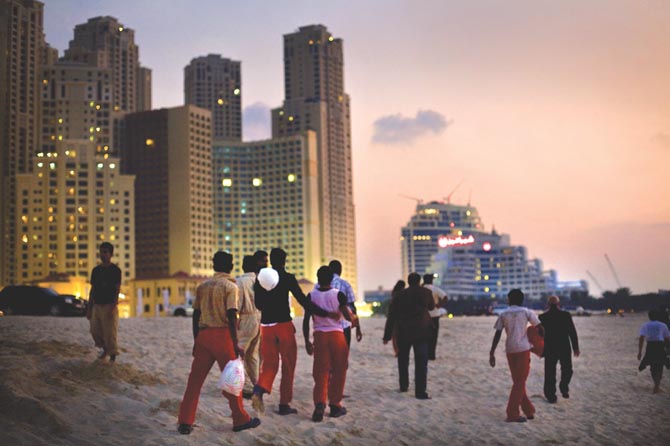 The day finally ends at sunset, usually around 7:30 PM.
The day finally ends at sunset, usually around 7:30 PM.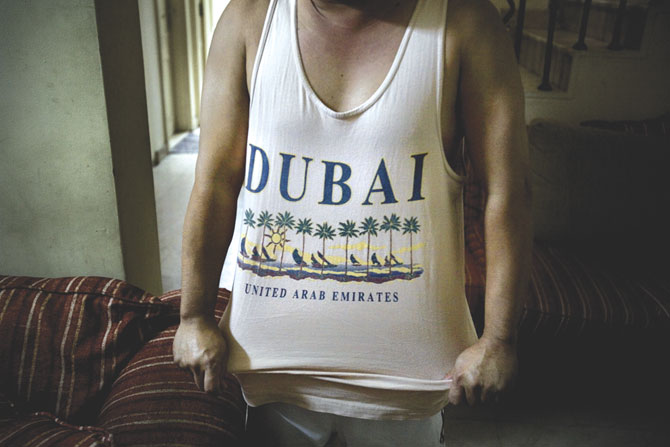 This was taken in Sonapur (“land of gold” in Hindi), Dubai’s largest labor camp, which embassies estimate houses upward of 50,000 workers—although, as with any official stats, these figures are questionable, and there are believed to be many more people living here.
This was taken in Sonapur (“land of gold” in Hindi), Dubai’s largest labor camp, which embassies estimate houses upward of 50,000 workers—although, as with any official stats, these figures are questionable, and there are believed to be many more people living here.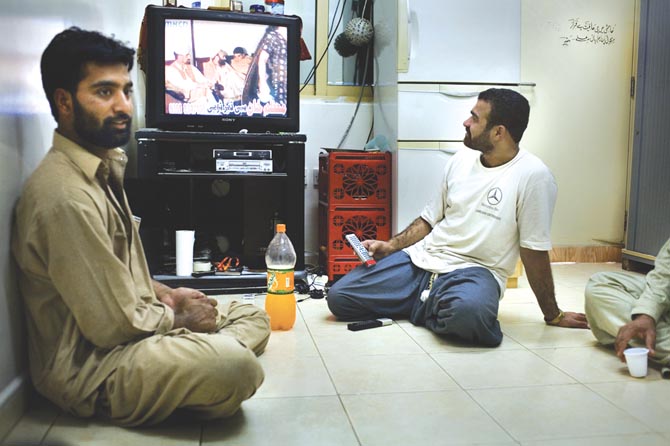 This is Ikram, on the left, with his friends in a rare moment of relaxation. As the economy begins to fail, they have been given a ticket home. They are not sure when, but over the next few days, they will be taken to the airport and shipped back to the mountains of Pakistan.
This is Ikram, on the left, with his friends in a rare moment of relaxation. As the economy begins to fail, they have been given a ticket home. They are not sure when, but over the next few days, they will be taken to the airport and shipped back to the mountains of Pakistan.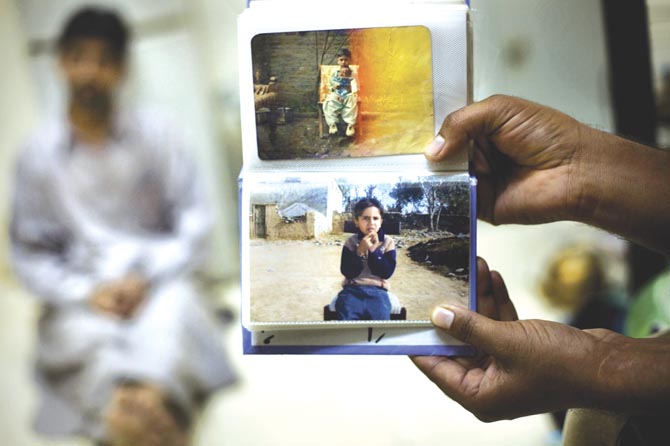 They’re excited to see their families again, but there is an overriding sense of the reality of serious debt. Most came to Dubai on broken promises—the recruiters painted them a pretty picture with rainbow-colored pencils made of lies. They have one month to leave after they’re fired. Whether they’ve worked two months or 20 years, no one can retire here.
They’re excited to see their families again, but there is an overriding sense of the reality of serious debt. Most came to Dubai on broken promises—the recruiters painted them a pretty picture with rainbow-colored pencils made of lies. They have one month to leave after they’re fired. Whether they’ve worked two months or 20 years, no one can retire here.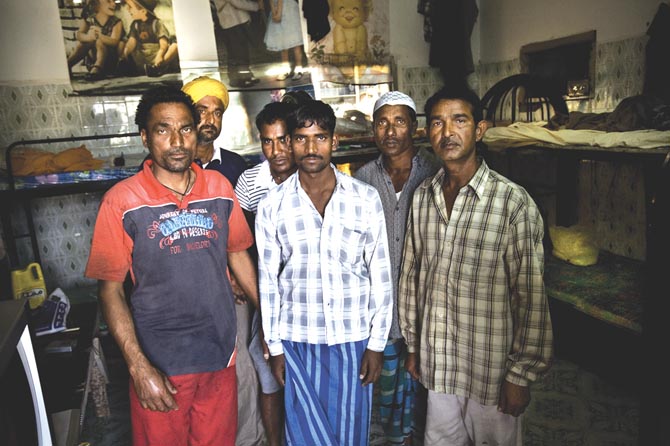 My photos don’t come anywhere close to portraying just how shitty these guys’ lives are. They’re one of the last modern vestiges of slavery.
My photos don’t come anywhere close to portraying just how shitty these guys’ lives are. They’re one of the last modern vestiges of slavery.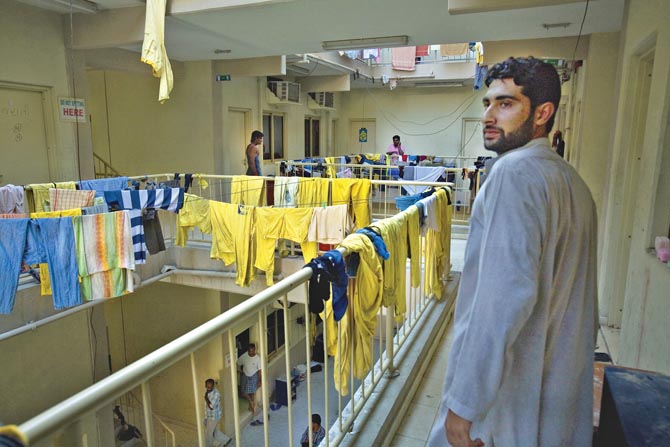 Imran was a goat herder from northern Pakistan. His family came together and pooled the cash for his flight to Dubai, with the promise of an exciting wage and solid work. On arrival, he was informed that this wage would be halved. Two months later, he was told that he must leave Dubai within three days. Tough luck, Imran.
Imran was a goat herder from northern Pakistan. His family came together and pooled the cash for his flight to Dubai, with the promise of an exciting wage and solid work. On arrival, he was informed that this wage would be halved. Two months later, he was told that he must leave Dubai within three days. Tough luck, Imran.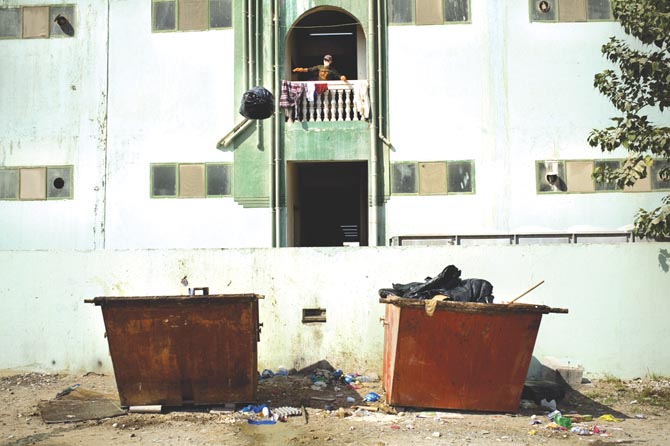 Life in Sonapur is squalid and rife with disease and illness. Open trash bins and sewage are everywhere.
Life in Sonapur is squalid and rife with disease and illness. Open trash bins and sewage are everywhere.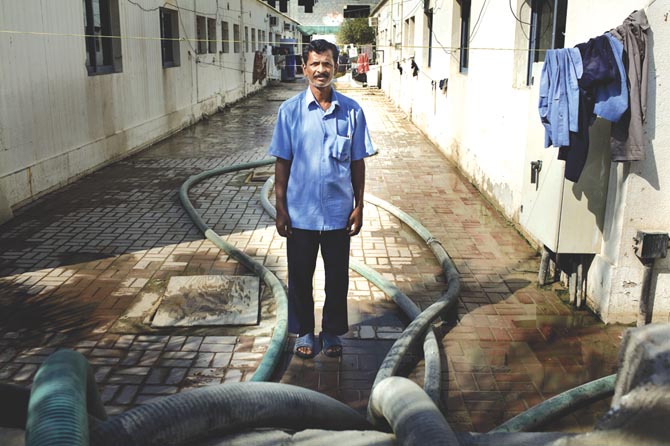 These are the huge pumps that pour the liquid waste out of the camps. They look like octopus tendrils snaking through the refuse-strewn streets.
These are the huge pumps that pour the liquid waste out of the camps. They look like octopus tendrils snaking through the refuse-strewn streets.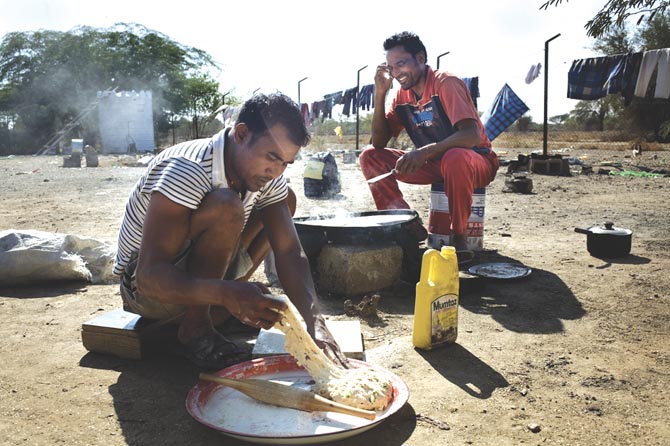 This is another workers’ camp I visited on the edge of nowhere. Around 30 Indian workers were living here after being miscounted and left to survive on dates that had fallen from trees. They’re healthier now, thanks to the woman who took me to see them. She was a company director who found them nearing starvation and blew the whistle.
This is another workers’ camp I visited on the edge of nowhere. Around 30 Indian workers were living here after being miscounted and left to survive on dates that had fallen from trees. They’re healthier now, thanks to the woman who took me to see them. She was a company director who found them nearing starvation and blew the whistle.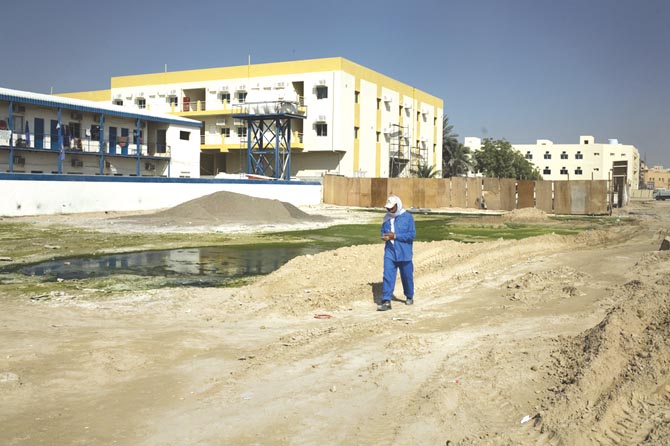 Sewage left in acrid open pools. You can smell this from miles away, before the camp is even in sight.
Sewage left in acrid open pools. You can smell this from miles away, before the camp is even in sight.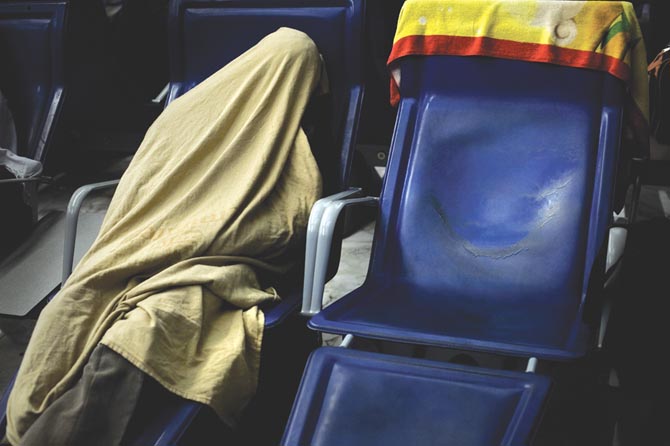 I followed Imran to the airport as he prepared to fly home.
I followed Imran to the airport as he prepared to fly home.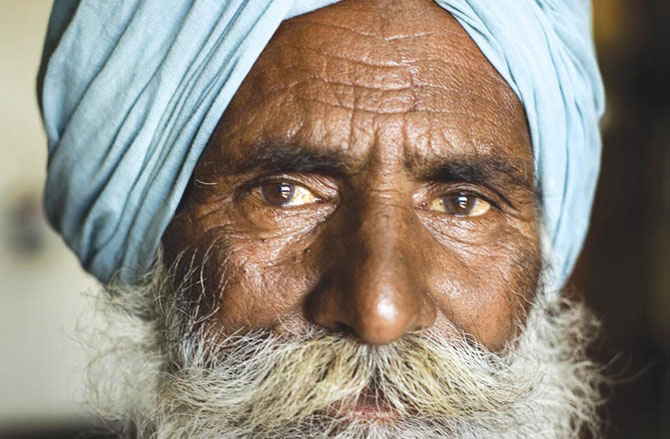 While over 58 percent of Dubai’s workforce is under the age of 15, not all of them are sprightly young whippersnappers. This guy was 62 and had feet like an elephant’s nuts.
While over 58 percent of Dubai’s workforce is under the age of 15, not all of them are sprightly young whippersnappers. This guy was 62 and had feet like an elephant’s nuts.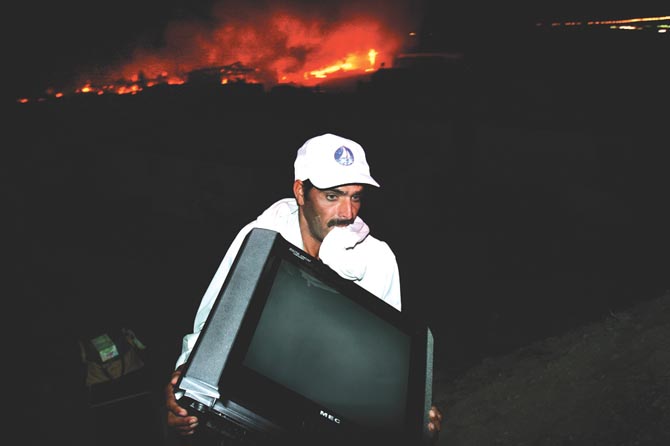 On my last night in the camp, the poor safety precautions finally caught up with the shitty living conditions, and a petrol fire broke out. The TV was the first thing to be saved.
On my last night in the camp, the poor safety precautions finally caught up with the shitty living conditions, and a petrol fire broke out. The TV was the first thing to be saved.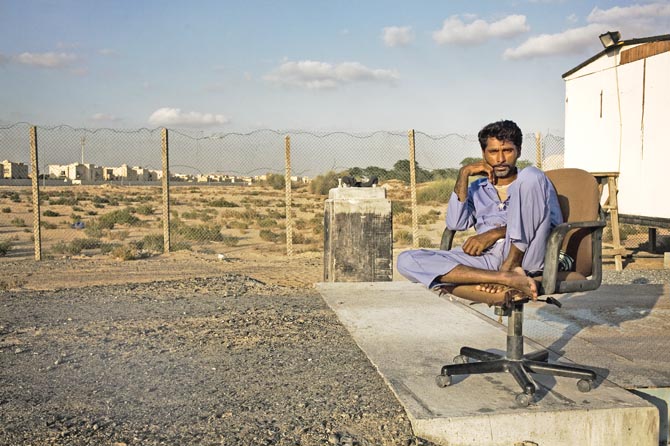 A security guard for a small-scale development.
A security guard for a small-scale development.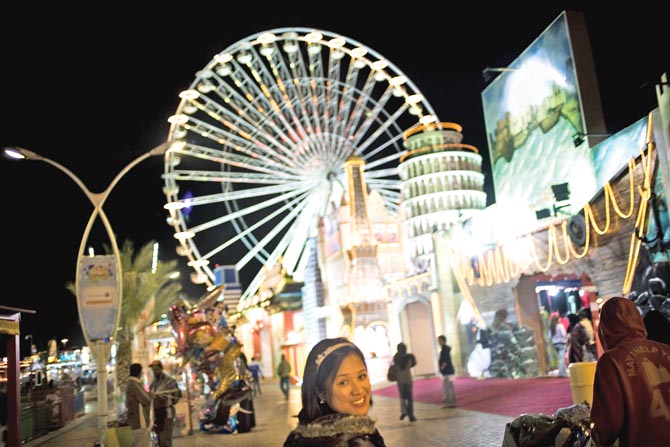 Here Jenny, a Filipina domestic worker I met, enjoys some downtime in the Global Village, one of the few leisure areas domestic servants are allowed to enter in Dubai.
Here Jenny, a Filipina domestic worker I met, enjoys some downtime in the Global Village, one of the few leisure areas domestic servants are allowed to enter in Dubai.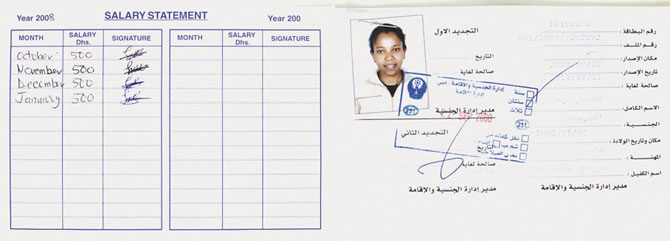 While the male workforce is often ignored but still out in the open, the plight of female domestic servants occurs behind closed doors and is equally harsh. I managed to get photos of a pay slip belonging to a domestic worker from Ethiopia named Alamanesh: 500 dirhams ($130) a month for working seven-day weeks and often 18-hour days. Migrant workers send billions of dollars home annually. UAE Exchange claims that in 2008 they turned around $12 billion, most of it to India, Bangladesh, and the Philippines.
While the male workforce is often ignored but still out in the open, the plight of female domestic servants occurs behind closed doors and is equally harsh. I managed to get photos of a pay slip belonging to a domestic worker from Ethiopia named Alamanesh: 500 dirhams ($130) a month for working seven-day weeks and often 18-hour days. Migrant workers send billions of dollars home annually. UAE Exchange claims that in 2008 they turned around $12 billion, most of it to India, Bangladesh, and the Philippines.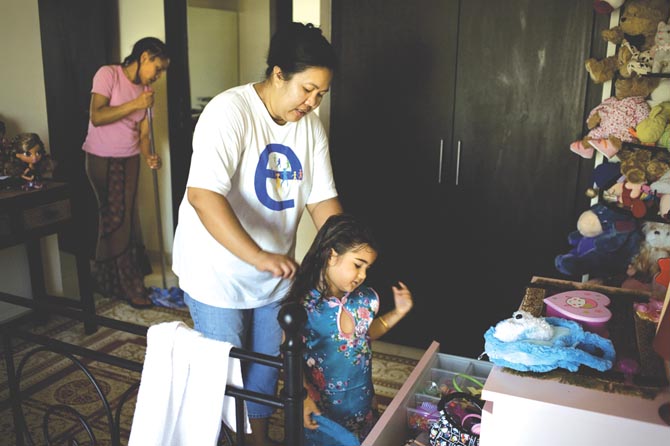 Alamanesh and Mali working in an Emirati home.
Alamanesh and Mali working in an Emirati home.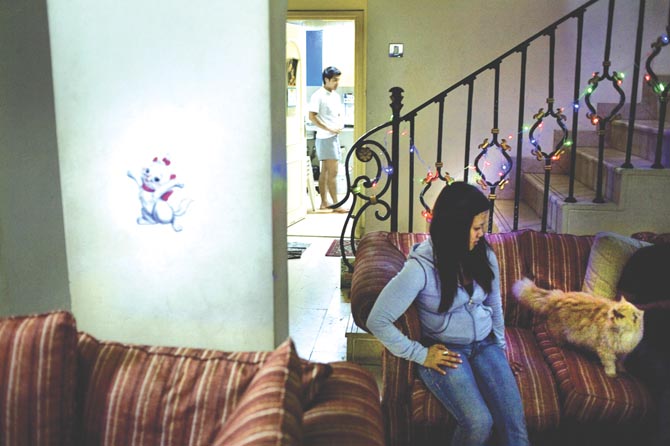 The government ruled that families must live in villas or flats, but female staff like Miss Suzi can’t afford the 150,000 dirhams that would cost. She lives with 24 others in a three-bedroom villa.
The government ruled that families must live in villas or flats, but female staff like Miss Suzi can’t afford the 150,000 dirhams that would cost. She lives with 24 others in a three-bedroom villa.


Advertisement






Advertisement






Advertisement







Advertisement








